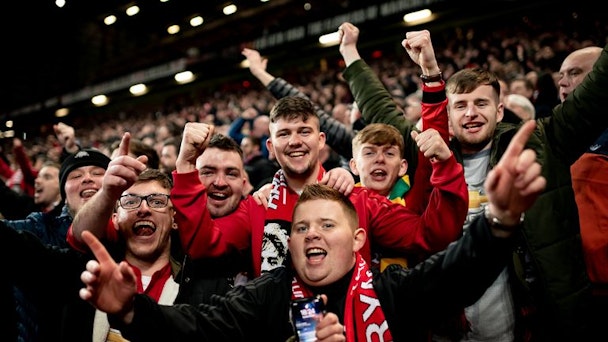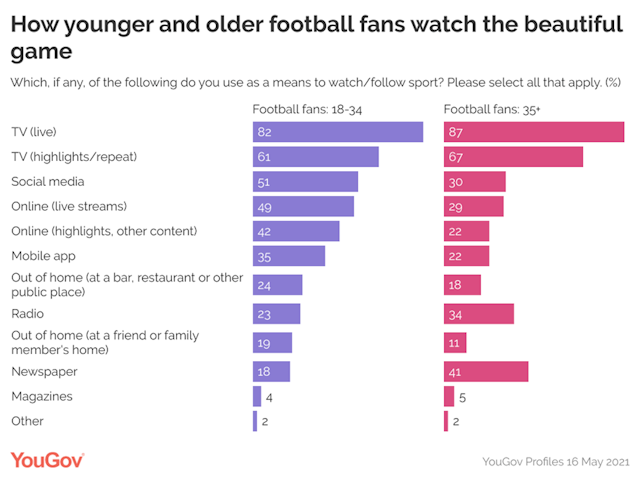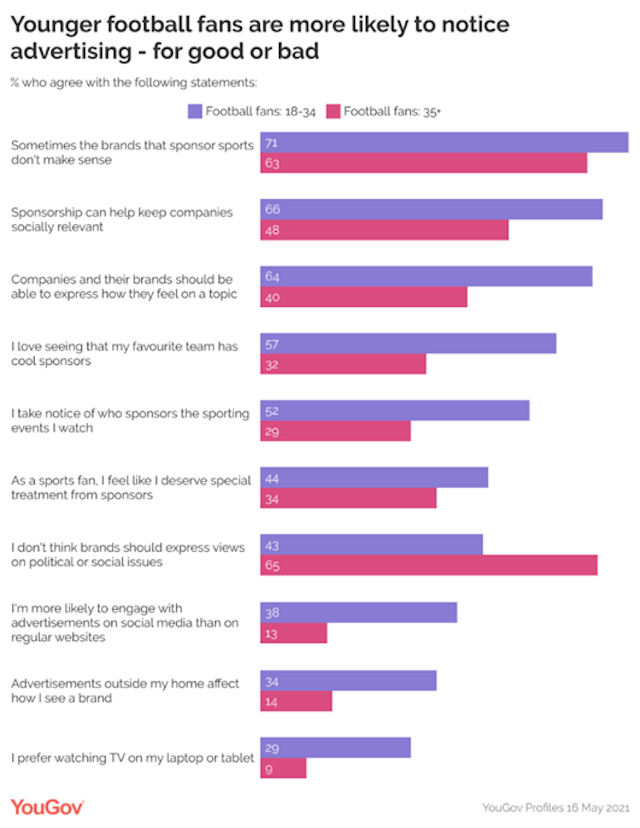Has football really lost its way its way with younger fans?
As the Euros kicks off YouGov delves into the data on whether young people really have lost interest in football, and what marketers can do to reach them.

Younger football fans are watching football in different ways to their older counterparts
In April, as he offered a defence of the European Super League, Real Madrid President Florentino Pérez declared that “young people are no longer interested in football”. Yet those arguments haven’t seemed to worry UK broadcasters, who this month signed up to roll over their existing contracts with the Premier League in a £4.7bn deal.
So what does YouGov’s data tell us about young people and the beautiful game – and how can marketers and advertisers more effectively reach them?
How they watch football
Comparing football fans aged 18-34 and over-35s reveals key differences in viewing preferences. While TV is still the most popular way to watch the game, older fans are more likely to turn on the telly to watch live football (87% v 82% of 18-34s) and highlights (67% v 61% of 18-34s).
Younger fans are more sceptical of the box. While four in five watch sport on live TV (82%), some may be doing so reluctantly. Three in ten (31%) say live TV is a thing of the past (compared to 20% of over-35s), and nearly as many say streaming is better than live TV (28%) compared to one in seven (14%) older football fans.
Where they watch football
Looking at the four major broadcasters involved in the renewed football rights deal shows that older fans are more likely to have recently watched Sky Sports (39% v 30% of 18-34s), BBC Sport (24% v17%), and BT Sport (24% v 21%). There’s more parity when it comes to Amazon Prime Video (30% v 31% of 18-34s) but we shouldn’t assume too much from this, given that the service comes free with the overall Amazon Prime package.

The gap can be partially explained through simple household economics. Two in five (39%) of the younger demographic live with their parents and therefore may not have control over their household TV situation – including which channels their household subscribes to.
But it’s likely no accident that Now TV, which doesn’t tie viewers to a longer-term contract, is more popular among 18-34s than over-35s (11% v 8%). Four in five younger football fans say streaming services have ‘changed TV watching’ for them (82% v 53% of over-35s), and the more long-term contracts offered by more traditional broadcasters could be putting them off. Offering more short-term viewing options to younger fans may help broadcasters reap greater commercial rewards among this group.
Younger fans notice marketing but expect more from it
Our data suggests that younger football fans are more attentive to marketing – but also expect more from it.
For instance, fans aged 18-34 are more likely to say they notice the brands that sponsor events (52% v 29% of over-35s). They’re also more likely to think sponsorship can help companies stay socially relevant (66% v 48% of over-35s), and nearly three in five agree that they love seeing that their favorite team has cool sponsors (57% v 32% of over-35s).

How and where to advertise to younger fans
However, with attention comes scrutiny. Fans aged 18-34 are more likely to say that the brands that sponsor sports don’t make sense (71% v 63% of over-35s), and that they deserve special discounts from those brands (44% v 34%). They may also have a poorer attention span: 18-34s are much more likely to say they’re bored all the time (40% v 25%).
So clubs, broadcasters and marketers should take care when addressing this audience: they watch the game differently, and they respond to promotions and communications differently too.
For example, while they’re less likely to say that TV ads have the biggest chance of getting their attention (20% v 34% of over-35s), online ads are more likely to catch their eye (31% v 19%). A quarter are also on TikTok (23%), so a short-form social strategy could also pay off. But content is key.
Younger fans want different messages and messengers
A big, bold message may be risky with over-35s (65% of them v 43% of 18-34s think brands shouldn’t express views on political or social issues), but most 18-34s think brands should be free to speak out when they feel strongly about an issue (64% of 18-34s v 40% of over-35s).
Marketers may also wish to consider how they select brand ambassadors aimed at younger fans. Fans aged 18-34 are more likely to cite wonderkids in continental leagues like Kylian Mbappe (16% v 9% of over-35s) and Erling Haaland (15% v 6% of over-35s) as favorites, while over-35s prefer Premier League stalwarts like Harry Kane (23% v 18% of 18-34s) and Mo Salah (20% v 16%).
While a campaign that appeals to naked self-interest – for example, a shirt sponsor promising exclusive discounts to fans of a particular team – may pay off, an ad fronted by Jadon Sancho that sensitively tackles themes of social responsibility could be just as effective.
2021 is half over, and the Premier League has already seen off the threat of a breakaway competition and the prospect of an open-market auction over broadcast rights. But while the current TV deals are preserved in amber until 2025, there’s evidence that fans may be changing. Will clubs, marketers and broadcasters change with them?
Amelia Brophy is head of account management at YouGov.
